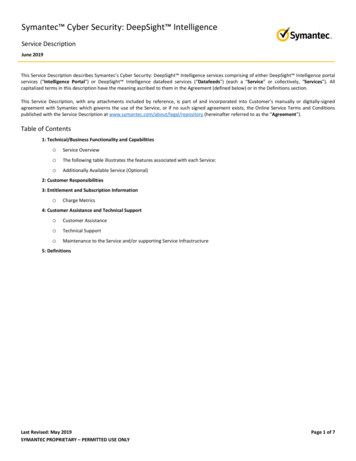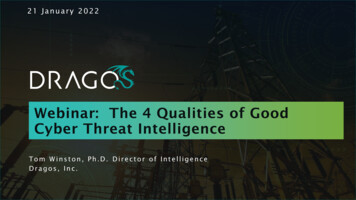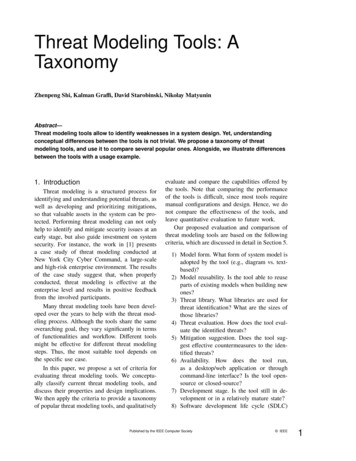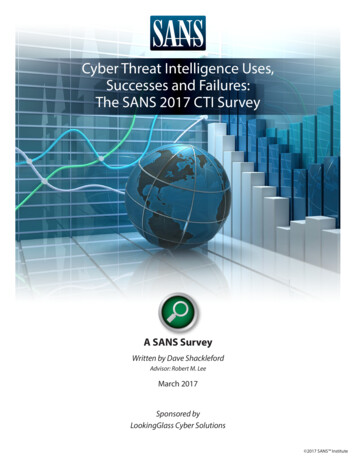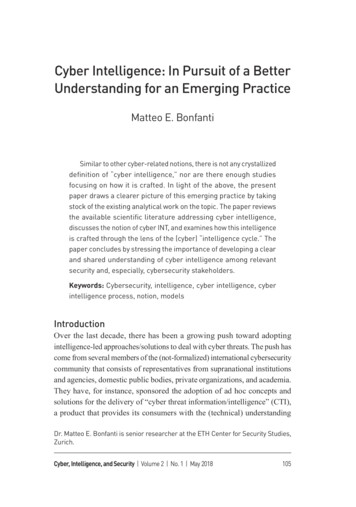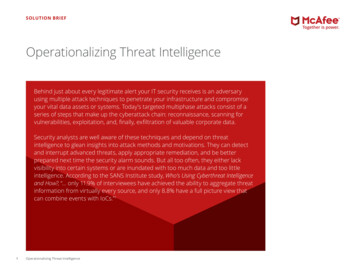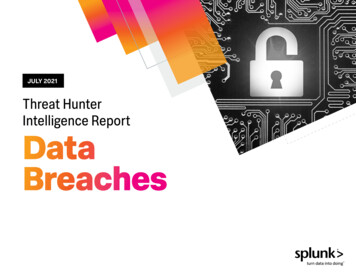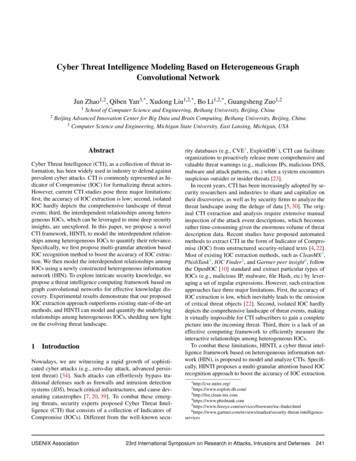
Transcription
Cyber Threat Intelligence Modeling Based on Heterogeneous GraphConvolutional NetworkJun Zhao1,2 , Qiben Yan3,* , Xudong Liu1,2,* , Bo Li1,2,* , Guangsheng Zuo1,212School of Computer Science and Engineering, Beihang University, Beijing, ChinaBeijing Advanced Innovation Center for Big Data and Brain Computing, Beihang University, Beijing, China3 Computer Science and Engineering, Michigan State University, East Lansing, Michigan, USAAbstractCyber Threat Intelligence (CTI), as a collection of threat information, has been widely used in industry to defend againstprevalent cyber attacks. CTI is commonly represented as Indicator of Compromise (IOC) for formalizing threat actors.However, current CTI studies pose three major limitations:first, the accuracy of IOC extraction is low; second, isolatedIOC hardly depicts the comprehensive landscape of threatevents; third, the interdependent relationships among heterogeneous IOCs, which can be leveraged to mine deep securityinsights, are unexplored. In this paper, we propose a novelCTI framework, HINTI, to model the interdependent relationships among heterogeneous IOCs to quantify their relevance.Specifically, we first propose multi-granular attention basedIOC recognition method to boost the accuracy of IOC extraction. We then model the interdependent relationships amongIOCs using a newly constructed heterogeneous informationnetwork (HIN). To explore intricate security knowledge, wepropose a threat intelligence computing framework based ongraph convolutional networks for effective knowledge discovery. Experimental results demonstrate that our proposedIOC extraction approach outperforms existing state-of-the-artmethods, and HINTI can model and quantify the underlyingrelationships among heterogeneous IOCs, shedding new lighton the evolving threat landscape.1IntroductionNowadays, we are witnessing a rapid growth of sophisticated cyber attacks (e.g., zero-day attack, advanced persistent threat) [34]. Such attacks can effortlessly bypass traditional defenses such as firewalls and intrusion detectionsystems (IDS), breach critical infrastructures, and cause devastating catastrophes [7, 20, 39]. To combat these emerging threats, security experts proposed Cyber Threat Intelligence (CTI) that consists of a collection of Indicators ofCompromise (IOCs). Different from the well-known secu-USENIX Associationrity databases (e.g., CVE1 , ExploitDB2 ), CTI can facilitateorganizations to proactively release more comprehensive andvaluable threat warnings (e.g., malicious IPs, malicious DNS,malware and attack patterns, etc.) when a system encounterssuspicious outsider or insider threats [23].In recent years, CTI has been increasingly adopted by security researchers and industries to share and capitalize ontheir discoveries, as well as by security firms to analyze thethreat landscape using the deluge of data [5, 30]. The original CTI extraction and analysis require extensive manualinspection of the attack event descriptions, which becomesrather time-consuming given the enormous volume of threatdescription data. Recent studies have proposed automatedmethods to extract CTI in the form of Indicator of Compromise (IOC) from unstructured security-related texts [4, 22].Most of existing IOC extraction methods, such as CleanMX 3 ,PhishTank4 , IOC Finder5 , and Gartner peer insight6 , followthe OpenIOC [10] standard and extract particular types ofIOCs (e.g., malicious IP, malware, file Hash, etc) by leveraging a set of regular expressions. However, such extractionapproaches face three major limitations. First, the accuracy ofIOC extraction is low, which inevitably leads to the omissionof critical threat objects [22]. Second, isolated IOC hardlydepicts the comprehensive landscape of threat events, makingit virtually impossible for CTI subscribers to gain a completepicture into the incoming threat. Third, there is a lack of aneffective computing framework to efficiently measure theinteractive relationships among heterogeneous IOCs.To combat these limitations, HINTI, a cyber threat intelligence framework based on heterogeneous information network (HIN), is proposed to model and analyze CTIs. Specifically, HINTI proposes a multi-granular attention based IOCrecognition approach to boost the accuracy of IOC extraction.1 http://cve.mitre.org/2 https://www.exploit-db.com/3 http://list.clean-mx.com4 https://www.phishtank.com5 er.html6 reat-intelligence-services23rd International Symposium on Research in Attacks, Intrusions and Defenses241
Then, HINTI leverages HIN to model the interdependent relationships among heterogeneous IOCs, which can depict amore comprehensive picture of threat events. Moreover, wepropose a novel CTI computing framework to quantify theinterdependent relationships among IOCs, which helps uncover novel security insights. In short, the main contributionsof this paper are summarized as follows: Multi-granular Attention based IOC Recognition.We propose multi-granular attention based IOC recognition approach to automatically extract cyber threat objects from multi-source threat texts, which can learn thesignificance of features with different scales. Our modeloutperforms the state-of-the-art methods in terms of IOCrecognition accuracy and recall. In total, we extract over397,730 IOCs from the unstructured threat descriptions. Heterogeneous Threat Intelligence Modeling. Wemodel different types of IOCs using heterogeneous information network (HIN), which introduces various metapaths to capture the interdependent relationships amongheterogeneous IOCs while depicting a more comprehensive landscape of cyber threat events. Threat Intelligence Computing Framework. We arethe first to present the concept of cyber threat intelligencecomputing, and design a general computing framework,as shown in Figure 5. The framework first utilizes aweight-learning based node similarity measure to quantify the interdependent relationships between heterogeneous IOCs, and then leverages attention mechanismbased heterogeneous graph convolutional networks toembed the IOCs and their interactive relations. Threat Intelligence Prototype System. To evaluate theeffectiveness of HINTI, we implement a CTI prototypesystem. Our system has identified 1,262,258 relationships among 6 types of IOCs including attackers, vulnerabilities, malicious files, attack types, devices andplatforms, based on which we further assess the realworld applicability of HINTI using three real-world applications: IOC significance ranking, attack preferencemodeling, and vulnerability similarity analysis.22.1BackgroundCyber Threat IntelligenceCyber Threat Intelligence (CTI) extracted from securityrelated data is structured information used to proactively resistcyber attacks. CTI consists of reasoning, context, mechanism,indicators, implications, and actionable advice about an existing or evolving cyber attack that can be used to createpreventive measures in advance [30]. CTI allows subscribersto expand their visibility into the fast-growing threat landscape, and enable early identification and prevention of a242cyber threat. Take WannaCry virus as an example, if securityguards can timely capture the threat intelligence that indicates“Wannacry permeates port 445 to attack systems", the malicious intrusion can be easily blocked by locking down port445, which is the most direct and effective way of combatingWannaCry virus [7].Meanwhile, social media (e.g., Blog, Twitter) has increasingly become an effective medium for exchanging and spreading cyber security information, on which security experts andorganizations often post their discoveries to reach a wideraudience promptly [32]. These posts usually include a magnitude of valuable security-related information [25, 26], suchas the warnings regarding latest vulnerabilities, hacking tools,data breaches, and existing or upcoming software patches,providing one of the main raw materials for extracting CTIs.Early CTI extraction requires extensive manual inspection of the threat descriptions, which becomes rather timeconsuming given the enormous volume of such descriptions. To facilitate the automatic generation and sharing ofCTI, a large volume of methods and frameworks are established, such as IODEF [13], STIX [4], TAXII [36], OpenIOC [10], and CyBox [28], CleanMX, PhishTank, IOC Finderand [2,22,31,46]. The majority of existing methods and frameworks leverage regular expressions to extract IOCs, whichmay suffer from a low accuracy due to their inability in predefining a comprehensive set of the IOC rules.2.2MotivationThe main goal of this research is to address the limitationsof the existing CTI analytics frameworks by modeling theinterdependent relationships among heterogeneous IOCs. Asa motivating example, given a security-related post: “Lastweek, Lotus exploited CVE-2017-0143 vulnerability to affecta larger number of Vista SP2 and Win7 SP devices in Iran.CVE-2017-0143 is a remote code execution vulnerability including a malicious file SMB.bat”. Most of the existing CTIframeworks can extract specific IOCs but neglect the relationships among them, as shown in Figure 1. It is obviousthat such IOCs could not draw a comprehensive picture ofthe threat landscape, let alone quantifying their interactiverelationships for in-depth security investigation.Different from the existing CTI frameworks, HINTI aimsto implement a computational CTI framework, which can notonly extract IOCs efficiently but also model and quantify therelationships between them. Here, we use the motivating example to illustrate how HINTI works step-by-step in practiceas follows.(i) First, the security-related post is annotated by the BI-O sequence tagging method [43] as shown in Figure 2,where B-X indicates that the element of type X is located atthe beginning of the fragment, I-X means that the elementbelonging to type X is located in the middle of the fragment,and O represents a non-essential element of other types. In this23rd International Symposium on Research in Attacks, Intrusions and DefensesUSENIX Association
Figure 1: An example of extracted IOCs without any relationsamong them.research, we annotated 30,000 such training samples from5,000 threat description texts, which are the raw materialsused to build our IOC extraction model.Figure 2: An annotation example with the B-I-O taggingmethod.(ii) The labeled training samples are then fed into the proposed neural network architecture as shown in Figure 6 totrain our proposed IOC extraction model. As a result, HINTIhas the ability to accurately identify and extract IOCs (e.g.,Lotus, SMB.bat) using the proposed multi-granular attentionbased IOC extraction method (see Section 4.1 for details).(iii) HINTI then utilizes the syntactic dependency parser[6] (e.g., subject-predicate-object, attributive clause, etc.) toextract associated relationships between IOCs, each of whichis represented as a triple (IOCi , relation, IOC j ). In this motivating example, HINTI extracts the relationship triples involving (Lotus, exploit,CV E 2017 0143), (CV E 2017 0143, a f f ect,VistaSP2), etc. Note that the extracted relational triples can be incrementally pooled into an HIN tomodel the interactions among IOCs for depicting a morecomprehensive threat landscape. Figure 3 shows a miniaturegraphic representation describing interactive relations amongIOCs extracted from the example. Compared with Figure 1, itis obvious that HINTI can depict a more intuitive and comprehensive threat landscape than the previous approaches. In thispaper, we mainly consider 9 relationships (R1 R9) among 6different types of IOCs (see Section 4.2 for details).(iv) Finally, HINTI integrates a CTI computing frameworkUSENIX AssociationFigure 3: A miniature of a constructed CTI includes attacker,vulnerability, malicious file, attack type, device, and platform,which describes a particular threat: an attacker utilizes CVE2017-0143 vulnerability to invade Vista SP2 and Win7 SP1devices. CVE-2017-0143 is a remote code execution vulnerability that involves a malicious file “SMB.bat".based on heterogeneous graph convolutional networks (seeSection 4.3) to effectively quantify the relationships amongIOCs for knowledge discovery. Particularly, our proposedCTI computing framework characterizes IOCs and their relationships in a low-dimensional embedding space, based onwhich CTI subscribers can use any classification (e.g., SVM,Naive Bayes) or clustering algorithms (K-Means, DBSCAN)to gain new threat insights, such as predicting which attackers are likely to intrude their systems, and identifying whichvulnerabilities belong to the same category without the expertknowledge. In this work, we mainly explore three real-worldapplications to verify the effectiveness and efficiency of theCTI computing framework: IOC significance ranking (seeSection 6.1), attack preference modeling (see Section 6.2),and vulnerability similarity analysis (see Section 6.3).2.3PreliminariesIn this paper, we use heterogeneous information network (HIN) to model the relationships among IOCs. Here, wefirst introduce the preliminary knowledge about HIN.Definition 1 Heterogeneous Information Network ofThreat Intelligence (HINTI) is defined as a directed graphG (V, E, T ) with an object type mapping function ϕ : V Mand a link type mapping function Ψ : E R. Each object v V belongs to one particular object type in the object typeset M: ϕ(v) M, and each link e E belongs to a particularrelation type in the relation type set R: Ψ(e) R. T denotesthe types of nodes and relationships.In this paper, we focus on 6 common types of IOCs: attacker (A), vulnerability (V), device (D), platform (P), malicious file (F), and attack type (T), and the links connectingdifferent objects represent different semantic relationships.To better understand the object types and relationship types inHINTI, it is imperative to provide the meta-level (i.e., schemalevel) description of the network. Consequently, we introduce23rd International Symposium on Research in Attacks, Intrusions and Defenses243
(a) Network schema.(b) Network instance.Figure 4: Network schema and instance of HIN containing 6 types of IOCs. (a): The network schema of HIN, which depictsbelongthe relationship template among different types of IOCs, such as Device Plat f orm. (b): An instance of network schema,belongwhich describes the concrete relationships between IOCs by following a network schema, e.g., O f f ice 2012 Windows.the network schema [37] for describing the meta-level relationships.Table 1: Meta-paths used in HINTI.Definition 2 Network Schema. The network schema ofHINTI, denoted as HS (A, R), is a meta template for G (V, E, T ) with the object type mapping ϕ : V M and the linktype mapping Φ : E R. It is a directed graph of object typesM with edges representing relations from R.The schema of HINTI specifies type constraints on the sets ofIOCs and their relationships. Figure 4 (a) shows the networkschema of HINTI, which defines the relationship templatesamong IOCs to effectively guide the semantic exploration inHINTI. For example, for a relationship that describes: “attackers invade devices", the semantic schema can be writteninvadeas: attacker device. Figure 4 (b) presents a concreteinstance of the network schema.Definition 3 Meta-path. A meta-path [37] P is a path sequence defined on a network schema S (N, R), and is repreRRRi12sented in the form of N1 N2 ··· Ni 1 , which definesa composite relation R R1 R2 · · · Ri 1 , where denotesthe composition operator on relations. A meta-path P is asymmetric path when the relation R defined by the path issymmetric (i.e, P is equal to P 1 ).Table 1 displays the meta-paths considered in HINTI. Forexample, the relationship “the attackers (A) exploit the samevulnerability (V)" can be described by a length-2 meta-pathexploitexploit attacker vulnerability attacker, denoted asAVAT (P4 ), which means that the two attackers exploit thesame vulnerability. Similarly, AV DPDT V T AT (P17 ) portraysa close relationship between IOCs that “two attackers wholeverage the same vulnerability invade the same type of deviceand ultimately destroy the same type of vice-Vul-AttackerArchitecture Overview of HINTIHINTI, as a cyber threat intelligence extraction and computing framework, is capable of effectively extracting IOCs fromthreat-related descriptions and formalizing the relationshipsamong heterogeneous IOCs to demystify new threat insights.As shown in Figure 5, HINTI consists of four major components, including: Data Collection and IOC Recognition. We first de-23rd International Symposium on Research in Attacks, Intrusions and DefensesUSENIX Association
Figure 5: The overall architecture of HINTI. HINTI consists of four major components: (a) collecting security-related data andextracting threat objects (i.e., IOCs); (b) modeling interdependent relationships among IOCs into a heterogeneous informationnetwork; (c) embedding nodes into a low-dimensional vector space using weight-learning based similarity measure; and (d)computing threat intelligence based on graph convolutional networks and knowledge mining.velop a data collection system to automatically capturesecurity-related data from blogs, hacker forum posts, security news, and security bulletins. The system utilizesa breadth-first search to collect the HTML source code,and then leverages Xpath (XML Path language) to extract threat-related descriptions. After that, we utilize amulti-granular attention based IOC recognition methodto extract IOC from the collected threat-related descriptions (see Section 4.1 for details). Relation Extraction and IOC modeling. HINTI addresses the challenge of CTI modeling by leveragingheterogeneous information networks, which can naturally depict the interdependent relationships betweenheterogeneous IOCs. As an example, Figure 4 shows amodel that capture the interactive relationships among attacker, vulnerability, malicious file, attack type, platform,and device (see Section 4.2 for details). Meta-path Design and Similarity Measure. Metapath is an effective tool to express the semantic relations among IOCs in constructed HIN. For instance,exploitexploit attacker vulnerability attacker, indicates that two attackers are related by exploiting the samevulnerability. We design 17 types of meta-paths (SeeTable 1) to describe the interdependent relationships between IOCs. With these meta-paths, we present a weightlearning based node similarity computing approach toquantify and embed the relationships as the premise forthreat intelligence computing. Threat Computing and Knowledge Mining. In thiscomponent, an effective threat intelligence computingframework is proposed, which can quantify and measureUSENIX Associationthe relevance among IOCs by leveraging graph convolutional network (GCN). Our proposed threat intelligencecomputing framework could reveal richer security knowledge within a more comprehensive threat landscape.44.1MethodologyMulti-granular Attention Based IOC ExtractionExtracting IOCs from multi-source threat texts is one of themajor tasks of threat intelligence analytics, and the qualityof the extracted IOCs significantly influences the analysisresults of cyber threats. Recently, Bidirectional Long ShortTerm Memory Conditional Random Fields (BiLSTM CRF)model [15] has demonstrated excellent performance in textchunking and Named-entity Recognition (NER). However,directly applying this model to IOC extraction is unlikely tosucceed, since threat texts usually contain a large number ofthreat objects with different grams and irregular structures.Consequently, we need an efficient method to learn the discriminative characteristics of IOCs with different sizes. In thispaper, we propose a multi-granular attention based IOC extraction method, which can extract threat objects with differentgranularity. Particularly, Figure 6 presents the proposed IOCextraction framework, which leverages the multi-granular attention mechanism to characterize IOCs. Different from thetraditional BiLSTM CRF model, we introduce new wordembedding features with different granularities to capture thecharacteristics of IOCs with different sizes. Furthermore, weutilize a self-attention mechanism to learn the importance ofthe features to improve the accuracy of IOC extraction.Our proposed method takes a threat description sentenceX (x1 , x2 , · · · , xi ) as input, where xi represents i-th word23rd International Symposium on Research in Attacks, Intrusions and Defenses245
to the type ŷi . Next, we utilize so f tmax function to normalizethe overall label score:p(Y X) eS(X,Y ) eS(X,Y )(5)ỹ YXWe design an objective function to maximize the probability p(Y X) to achieve the highest label score for differentIOCs, which can be written as follows:argmax log(p(Y X)) argmax (S(X,Y ) log(Figure 6: The framework of multi-granular IOC extraction.in X. We first chunk the sentence into n-gram componentsincluding char-level, 1-gram, 2-gram, and 3-gram, which arethe inputs of our trained model, written as follows:jexji Vembedding (xi ),(1)jwhere Vembedding transforms the chunk with granularity j intoa vector space and xi is the i-th word in a sentence X. Thus,the threat description sentence Xi can be vectorized as follows: jhi LST M f orward ([exj0 , exj1 , · · · , exji ]) j(2)hi LST Mbackward ([exj0 , exj1 , · · · , exji ]) j jwhere hi and hi are the embedded features learned byforward LSTM and backward LSTM, respectively. Let O bethe output of Bi-LSTM, which is a weighted sum of embeddedfeatures with weights corresponding to the importance ofdifferent features:O H ·W T(3) j j jjjjjwhere H βi σ(h1 , h2 , · · · , hi ), hi (hi hi ), βi is thejweight vector to represent the importance of hi , in whichj and i are the segmentation granularity of sentences and thecorresponding index of the chunk. W is the parameter matrix.Given a security-related sentence X (x1 , x2 , · · · , xi ), itscorresponding threat object sequence Y (ŷ1 , ŷ2 , · · · , ŷi ), andits output of Bi-LSTM O, we can compute the overall labelscore of X and Y as follows:nS(X,Y ) (Aŷi ,ŷi 1 Oi,ŷi )(4)i 0where Aŷi ,ŷi 1 is the state transition matrix in CRF model, andOi,ŷi , as the output of Bi-LSTM hidden layer (calculated byEq. (3)), represents the label score of i-th word corresponding246 eS(X,ỹ) ))(6)ỹ YXBy solving the objective function above, we assign correctlabels to the n-gram components, according to which we canidentify the IOCs with different lengths. Our multi-granularattention based IOC extraction method is capable of identifying different types of IOCs, and its evaluation is presented inSection 5.4.2Cyber Threat Intelligence ModelingCTI modeling is an important step to explore the intricaterelationship between heterogeneous IOCs. In our work, HINis introduced to group different types of IOCs into a graphto explore their interactive relationships. In this section, weportray the main principle of threat intelligence modeling.To model the intricate interdependent relationships amongIOCs, we define the following 9 relationships among 6 typesof IOCs as follows. R1: To depict the relation of an attacker and the exploited vulnerability, we construct the attacker-exploitvulnerability matrix A. For each element Ai, j {0, 1},Ai, j 1 indicates attacker i exploits vulnerability j. R2: To depict the relation of an attacker and a device,we build the attacker-invade-device matrix D. For eachelement Di, j {0, 1}, Di, j 1 indicates attacker i invadesdevice j. R3: Two attacker can cooperate to attack a target. Tostudy the relationship of attacker-attacker, we constructthe attacker-cooperate-attacker matrix C. For each element Ci, j {0, 1}, Ci, j 1 indicates there exists a cooperative relationship between attacker i and j. R4: To describe the relation of a vulnerability and theaffected device, we build the vulnerability-affect-devicematrix M. For each element Mi, j {0, 1}, Mi, j 1 indicates vulnerability i affects device j. R5: A vulnerability is often labeled as a specific attacktype by Common Vulnerabilities and Exposures (CVE)23rd International Symposium on Research in Attacks, Intrusions and DefensesUSENIX Association
system7 . To explore the relation of vulnerability-attacktype, we build the vulnerability-belong-attack type matrix G, where each element Gi, j {0, 1} denotes if vulnerability i belongs to an attack type j. R6: A vulnerability often involves one or more maliciousfiles. To describe the relation of vulnerability-file, webuild the vulnerability-include-file matrix F. For eachelement Fi, j {0, 1}, Fi, j 1 denotes that vulnerability iincludes malicious file j. R7: A malicious file often targets a specific device. Weestablish the file-target-device matrix T to explore therelation of file-device. For each element Ti, j {0, 1},Ti, j 1 indicates malicious file i targets device j. R8: Oftentimes, a vulnerability evolves from another.To study the relationship of vulnerability-vulnerability,we build the vulnerability-evolve-vulnerability matrixE, where each element Ei, j {0, 1} indicates if vulnerability i evolves from vulnerability j. R9: To depict the relation device-platform that a device belongs to a platform, we build the device-belongplatform matrix P where each element Pi, j {0, 1} illustrates if device i belongs to platform j.Based on the above 9 types of relationships, HINTIleverages the syntactic dependency parser [6] (e.g., subjectpredicate-object, attributive clause, etc.) to automatically extract the 9 relationships among IOCs from threat descriptions,each of which is represented as a triple (IOCi , relation, IOC j ).For instance, given a security-related description: “On May12, 2017, WannaCry exploited the MS17-010 vulnerabilityto affect a larger number of Windows devices, which is aransomware attack via encrypted disks". Using the syntacticdependency parser, we can extract the following triples: (WannaCry, exploit, MS17-010), (MS17-010, affect, Windows device), (WannaCry, is, ransomware). Such triples extractedfrom various data sources can be incrementally assembledinto HINTI to model the relationships among IOCs, whichcould offer a more comprehensive threat landscape that describes the threat context. Particularly, we further define 17types of meta-paths shown in Table 1 to probe into the interdependent relationships over attackers, vulnerabilities, maliciousfiles, attack types, devices, and platforms. HINTI is able toconvey a richer context of threat events by scrutinizing 17types of meta-paths and reveal the in-depth threat insightsbehind the heterogeneous IOCs (see Section 6 for details).4.3Threat Intelligence ComputingIn this section, we illustrate the concept of threat intelligencecomputing, and design a general threat intelligence computing7 http://cve.mitre.org/USENIX Associationframework based on heterogeneous graph convolutional networks, which quantifies and measures the relevance betweenIOCs by analyzing meta-path based semantic similarity. Here,we first provide a formal definition of threat intelligence computing based on heterogeneous graph convolutional networks.Definition 4 Threat Intelligence Computing Based onHeterogeneous Graph Convolutional Networks. Given thethreat intelligence graph G (V, E), the meta-path set M {P1 , P2 , · · · , Pi }. The threat intelligence computing: i) computes the similarity between IOCs based on meta-path Pi togenerate corresponding adjacency matrix Ai ; ii) constructsthe feature matrix of nodes Xi by embedding attribute information of IOCs into a latent vector space; iii) conductsgraph convolution GCN(Ai , Xi ) to quantify the interdependentrelationships between IOCs by following meta-path Pi , andembeds them into a low-dimensional space.The threat intelligence computing aims to model the semantic relationships between IOCs and measure their similaritybased on meta-paths, which can be used for advanced security knowledge discovery, such as threat object classification,threat type matching, threat evolution analysis, etc. Intuitively,the objects connected by the most significant meta-paths tendto bear more similarity [37]. In this paper, we propose aweight-learning based threat intelligence similarity measure,which uses self-attention to improve the performance of similarity measurement between any two IOCs. This method canbe formalized as below:Definition 5 Weight-learning based Node Similarity Measure. Given a set of symmetric meta-path set0P [Pm ]Mm 1 , the similarity S(hi , h j ) between any two IOCshi and h j is defined as:M0 S(hi , h j ) wm2· {hi j Pm } {hi i Pm } {h j j Pm } (7)where hi j hm is a path instance between IOC hi andh j following meta-path Pm , hi i Pm is that between IOCinstance hi and hi , and h j j Pm is that between IOC instance h j and h j , where {hi j Pm } CPm (i, j), {hi i Pm } CPm (i, i), {h j j Pm } CPm ( j, j), and CPm is the commuting matrix based on meta-path Pm defined below. w [w1 , . . . , wm , . . . , wM0 ] denote the meta-path weights, where0wm is the weight of meta-paths Pm , and M is the number ofmeta-paths.S(hi , h j ) is defined in two parts: (1) th
Cyber Threat Intelligence (CTI), as a collection of threat in- . of the existing CTI analytics frameworks by modeling the . malicious file, attack type, device, and platform, which describes a particular threat: an attacker utilizes CVE-2017-0143 vulnerability to invade Vista SP2 and Win7 SP1 devices. CVE-2017-0143 is a remote code .


